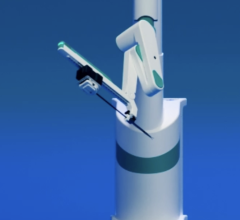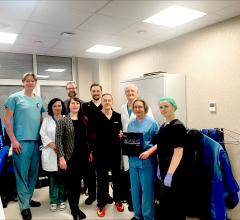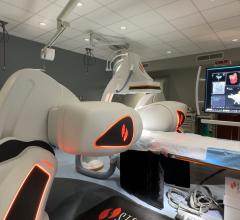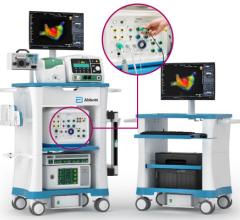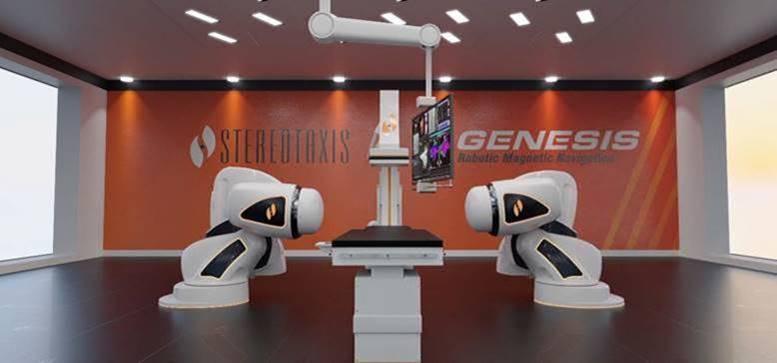
Robotic electrophysiology operating room including Stereotaxis Genesis RMN and Stereotaxis Imaging Model S systems. Image courtesy of Stereotaxis.
May 9, 2019 – Stereotaxis introduced Stereotaxis Genesis RMN, its next-generation robotic platform that it claims is a significant advancement in robotic magnetic navigation technology.
The Stereotaxis Genesis RMN system provides the established benefits and reliability of robotic magnetic navigation in an architecture that is faster, smaller, lighter and more flexible. Since the original launch of the Niobe I system in 2003, improvements in Stereotaxis’ robotic system have remained iterative. Genesis RMN utilizes novel smaller magnets that rotate along their center of mass and are held by flexible robotic arms. This mechanism allows for instantaneous responsiveness to physician control and the flexibility to accommodate an increased range of motion. The Genesis RMN system’s significant reduction in size will improve the patient experience, according to Stereotaxis, and provides physicians and nurses greater access to the patient during the procedure.
Stereotaxis Genesis RMN is being launched concurrently with Stereotaxis Imaging Model S as an integrated complete solution for a robotic interventional operating room. Stereotaxis Imaging Model S is a single-plane, full-power X-ray system designed to be specifically available with the Genesis RMN system. It includes the C-arm, powered table, motorized boom and large high-definition monitors. Developed in collaboration with Omega Medical Imaging, Stereotaxis Imaging incorporates modern fluoroscopy technology designed to support high-quality imaging while minimizing radiation exposure for patients and physicians. The combination of Genesis RMN with Stereotaxis Imaging in a tightly integrated fashion significantly reduces the cost of acquisition, the ongoing cost of ownership and the complexity of installation of a robotic electrophysiology practice.
“We are enthusiastic about the reinvigorated robotic innovation by Stereotaxis and are excited to see how this technology advances the field of electrophysiology,” said Andrea Natale, M.D., cardiac electrophysiologist and executive medical director, Texas Cardiac Arrhythmia Institute at St. David's Medical Center.
“Dr. Natale and I had the opportunity to observe the Genesis and Stereotaxis Imaging systems in person,” said J. David Burkhardt, M.D., cardiac electrophysiologist, Texas Cardiac Arrhythmia Institute at St. David's Medical Center. “I consider this a significant and impressive leap forward, and am excited to see the positive impact of this innovation on patient care, procedure efficiency and the overall experience in the electrophysiology lab.”
Stereotaxis Genesis RMN is CE marked and available for commercialization across various EU geographies. Availability in other global geographies is subject to regulatory approvals, which will be pursued in the coming months. Stereotaxis Imaging Model S has U.S. Food and Drug Administration (FDA) clearance, CE mark, and is commercially available in the U.S., EU and certain other global geographies. Stereotaxis Imaging Model S is compatible with Niobe.
For more information: www.stereotaxis.com
Related EP Robotic Systems Content:
VIDEO: Virtual Tour of the Robotic Electrophysiology Lab at Banner Health — Interview with Peter Weiss, M.D.
VIDEO: Advantages of Robotic Ablation in the EP Lab — Interview with Peter Weiss, M.D.
Time to Take Another Look at Robotics in Electrophysiology — Article by Peter Weiss, M.D.
Stereotaxis Announces Next-generation Robotic Magnetic Navigation and Imaging Systems
Stereotaxis and Acutus Medical Announce Strategic Collaboratio
Find more news on robotic cath lab and EP lab systems
Time to Take Another Look at Robotics in Electrophysiology — Article by Peter Weiss, M.D.
VIDEO: Advantages of Robotic Ablation in the EP Lab — Interview with Peter Weiss, M.D.
Stereotaxis and Acutus Medical Announce Strategic Collaboration

 June 11, 2024
June 11, 2024 

